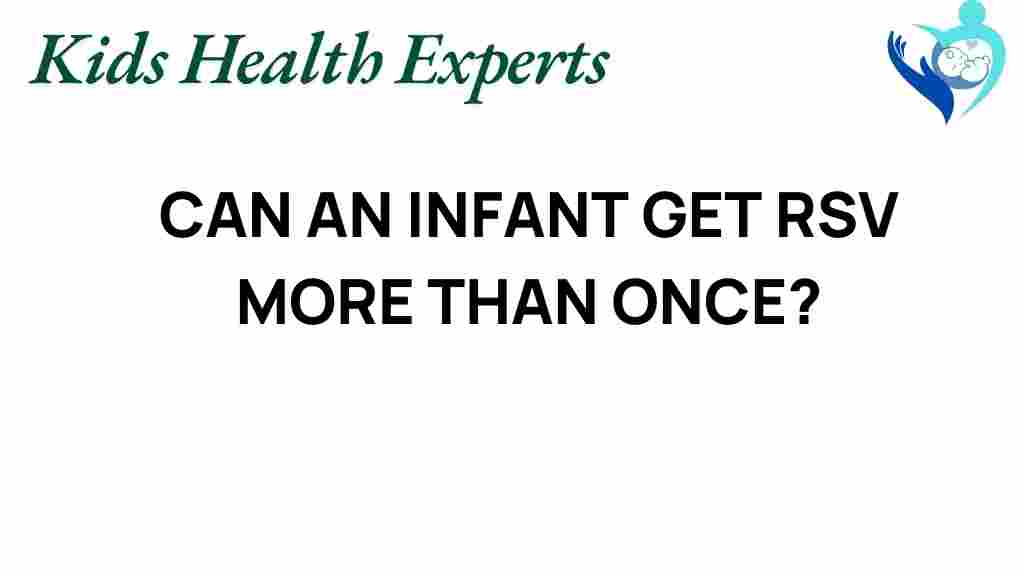Unraveling the Mystery: Can Infants Get RSV More Than Once?
Respiratory syncytial virus (RSV) is a common viral infection that primarily affects infants, particularly during the colder months. As a parent or caregiver, understanding the nature of RSV, especially regarding reinfection, is crucial for maintaining your child’s health. In this comprehensive article, we will explore whether infants can get RSV more than once, the health risks associated with reinfection, and how to safeguard your child’s health during RSV season.
Understanding RSV in Infants
Respiratory syncytial virus (RSV) is one of the leading causes of respiratory infections in infants and young children. The virus attacks the respiratory tract, leading to symptoms that can range from mild cold-like signs to severe respiratory distress. For many infants, RSV is their first experience with a viral infection, and it can significantly impact their health.
What Is RSV?
RSV is a highly contagious virus that spreads through respiratory droplets when an infected person coughs or sneezes. It can also survive on surfaces, making it easy for infants to contract the virus through touch. The typical symptoms of RSV include:
- Runny nose
- Coughing
- Wheezing
- Fever
- Decreased appetite
Health Risks for Infants
For most healthy infants, RSV resolves on its own; however, infants at higher risk—such as those born prematurely, with congenital heart defects, or with weakened immune systems—may experience severe complications. These can include:
- Pneumonia
- Bronchiolitis
- Hospitalization
Understanding the severity of RSV is essential for parents and caregivers to recognize when to seek pediatric care.
Can Infants Get RSV More Than Once? Understanding Reinfection
One of the most pressing questions regarding RSV is whether infants can experience reinfection. The answer is yes—infants can get RSV more than once. In fact, many children will contract RSV multiple times during their early years.
The Nature of RSV and Immunity
When an infant is infected with RSV, their immune system generates a response that helps build some level of immunity. However, this immunity is not long-lasting. The body may not have enough memory cells to prevent future infections, which means that even if an infant has had RSV once, they are still susceptible to reinfection.
Why Reinfection Occurs
Several factors contribute to the likelihood of RSV reinfection:
- Viral Variability: RSV has different strains, and immunity to one strain does not guarantee protection against another.
- Age and Immune Development: Infants’ immune systems are still developing, making them more vulnerable to viral infections.
- Environmental Factors: Infants who are often in crowded places or around other children are at a higher risk of exposure.
Preventing RSV Reinfection in Infants
While RSV reinfection is common, there are several steps parents can take to reduce the risk of their infants contracting the virus again.
Hygiene Practices
Good hygiene can significantly lower the chances of RSV infection:
- Handwashing: Ensure that all caregivers and family members wash their hands regularly, especially before handling your infant.
- Avoiding Crowds: Limit exposure to crowded places, especially during RSV season.
- Disinfecting Surfaces: Regularly disinfect surfaces that may harbor the virus, such as toys and countertops.
Health Monitoring
Monitoring your infant’s health can also help catch symptoms early:
- Watch for Symptoms: Be vigilant for cold-like symptoms, especially during RSV season.
- Pediatric Care: Schedule regular check-ups with your pediatrician to discuss any concerns about your infant’s respiratory health.
Step-by-Step Guide for Parents: What to Do If Your Infant Shows Symptoms of RSV
If you suspect that your infant may have contracted RSV, here is a step-by-step guide:
- Step 1: Monitor Symptoms: Keep a close eye on your infant’s symptoms. Common signs include a runny nose, cough, and wheezing.
- Step 2: Consult Your Pediatrician: If your infant exhibits severe symptoms such as difficulty breathing, high fever, or lethargy, contact your pediatrician immediately.
- Step 3: Follow Treatment Recommendations: Your pediatrician may suggest treatments to alleviate symptoms, such as humidified air or nasal suctioning for congestion.
- Step 4: Keep Your Infant Hydrated: Ensure your infant stays hydrated, as dehydration can occur with fever and illness.
- Step 5: Monitor for Complications: Be aware of signs of complications such as increased wheezing, difficulty breathing, or blue-tinted skin, and seek emergency care if needed.
Troubleshooting Tips for Parents
Dealing with RSV can be stressful for parents. Here are some troubleshooting tips to help manage your infant’s condition:
- Maintain Calmness: Keeping a calm demeanor can help soothe your infant during distressing episodes.
- Use a Humidifier: A cool-mist humidifier in your infant’s room can help ease breathing difficulties.
- Keep Your Infant Upright: Holding your infant in an upright position can help reduce coughing and improve breathing.
- Limit Exposure to Irritants: Avoid smoke, strong perfumes, and other irritants that can exacerbate respiratory issues.
Conclusion: Protecting Your Infant from RSV Reinfection
In summary, RSV is a common yet potentially serious viral infection that can affect infants multiple times during their early years. Understanding the nature of RSV and its implications for children’s health is vital for all parents. By implementing strong hygiene practices, monitoring symptoms, and consulting with healthcare professionals, you can significantly reduce the risks associated with RSV reinfection.
As always, if you have concerns about your infant’s health, do not hesitate to reach out to your pediatrician for guidance and support. For more information on RSV prevention and care, you can visit CDC’s RSV Information Page.
By staying informed and proactive, you can help ensure that your infant remains healthy and safe from the risks posed by respiratory syncytial virus.
This article is in the category Conditions and created by KidsHealthExperts Team
